This section covers
This section covers

A message from the chief driving examiner
Each year thousands of men, women and children are killed or seriously injured on roads in Great Britain. The majority of the crashes that result in these deaths and injuries are caused by human error. This makes it vital that every driver understands the responsibility that driving a car brings with it and the importance of making safety their overriding priority.
Safe driving is all about developing the right attitude and approach, and combining this with a sound knowledge of defensive driving techniques. It means not only driving with courtesy and consideration for everyone else, but also being prepared to make allowances for the mistakes of others.
The increasing volume of traffic on our roads today means you’ll often find yourself driving in crowded conditions on all types of road. By adopting the correct attitude and taking pride in your driving, you’ll ensure that this convenient means of transport remains both safe and enjoyable.
The predecessor to this book, The Official Driving Manual, has long been recognised as an essential reference book for every motorist, regardless of experience, and for instructors too. This latest edition has been updated to take account of changes in legislation, roads, vehicles and driving techniques and procedures. Read this book carefully – and put into practice the advice it gives. Above all, make sure your aim is ‘safe driving for life’.

Chief Driving Examiner
No matter how good, how fast, how expensive or how efficient your vehicle is, it’s you, the driver, who determines whether it’s a safe means of transport.
Driver skill and driver attitude are two key areas that determine your approach behind the wheel.
There is, after all, a lot of enjoyment and satisfaction to be gained from showing not only your skill and ability but also courtesy and consideration to those around you. Apart from the reward of a nod or smile in appreciation, you’ll have the added satisfaction of knowing you’re making our roads that much safer.
The right attitude and behaviour are the key factors to becoming a good driver. A good driver isn’t a perfect driver; it’s very doubtful whether such a driver exists. Nevertheless, apart from skill and experience, which only come with time, a good driver needs
•responsibility
•concentration
•anticipation
•patience
•confidence.
Together, these qualities go to make up what’s generally known as the driver’s attitude. It’s attitude which, in turn, influences driver behaviour.
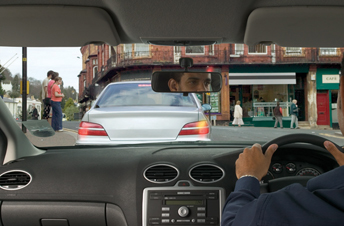
Remember, it’s a fact that nearly all road traffic incidents are caused, to some degree, by the driver. Reducing them is the responsibility of every driver.
Developing the right attitude and behaviour will come more easily to some drivers than others, but these attributes are so important to safe driving that it’s vital for every driver to make the effort to keep working on them. Take pride in your driving and remember that, even if you’ve been driving for years, there’s always something to learn.
As a responsible driver, you must always be concerned for the safety of
•yourself
•your passengers
•all other road users.
Yourself See pages 17–19.
Your passengers Be aware of any particular needs of your passengers; for example, if they have mobility problems or are suffering from an illness that might require additional attention. Be aware also of your responsibilities regarding the use of seat belts by your passengers (see page 39).
Other road users Be tolerant; remember that everyone is entitled to use the road. This may mean making allowances for other road users from time to time, particularly the most vulnerable, such as
•children and older people
•people with disabilities
•cyclists and motorcyclists
•people in charge of animals.
Look around you, and plan your actions well ahead to avoid causing danger or inconvenience. In this way you can avoid the temptation to act hastily – perhaps with dire consequences.
Be responsible by recognising your own limitations and those of others.
Remember, the responsibility for safe driving rests with you.
To be able to drive safely in today’s traffic conditions, you must have 100% concentration.
If you let your mind wander, even for a moment, the risk of making a mistake is increased enormously, and mistakes frequently lead to incidents.
Avoid driving if you’re
•feeling tired or unwell
•thinking about something else
•upset or annoyed
•suffering stress of any kind.
If you have to drive under any of these conditions, try to give yourself more time to react.
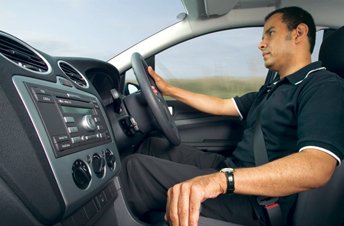
Concentration is the key to anticipation and is helped by having
•good vision
•good hearing
•good health
•self-discipline.
If you have any in-vehicle system such as satellite navigation, congestion warning or a vehicle management system, don’t let these divert your attention from driving or reduce your concentration. Restrict any visual or manual interaction with the system to an absolute minimum. In the interests of safety, you should find an appropriate, safe and legal place to stop before making any adjustments.
While on the move don’t
•make or answer phone calls or texts
•use iPods or generic MP3 players
•look at road maps or route guidance and navigation systems
•get distracted when tuning the radio or changing CDs
•let conversation distract you (an argument with your passengers can be particularly distracting)
•listen to loud music or use headphones of any kind, as these can mask other sounds
•be distracted by eating, drinking (even non-alcoholic drinks) or smoking.
In addition, don’t
•stick non-essential stickers on the windows of your vehicle; they can restrict your view
•hang objects in your vehicle (eg dolls, dice, etc) where they might distract you and restrict your view.
Passengers Passengers can be a major source of distraction, particularly if they’ve been drinking or taking drugs. However it can also be distracting even if they’re just talking to you, using a mobile phone or moving around unnecessarily.

You MUST NOT use a hand-held mobile phone, or other similar device, when driving, except to call 999 or 112 in a genuine emergency when it’s unsafe or impractical to stop.
Using any phone or microphone, even if it’s hands-free, can also divert your attention from the road. It’s far safer not to use any phone while driving.
Find a safe place to stop before making a call. Use voicemail to receive calls and make regular stops to retrieve messages.
Driving requires all of your attention, all of the time.
These rules apply even if you’re not driving but are supervising a learner driver.
Anticipation in driving means planning well ahead and acting promptly to deal with the changes going on around you. It should, with experience, become almost an automatic reaction. It’s the hallmark of a good driver.
You need to continually question the actions of other road users.
If you plan ahead and try to anticipate the actions of others, you can
•avoid being taken by surprise
•prevent some hazards developing
•save fuel by anticipating situations early so that you can plan your approach and therefore keep moving when it’s safe to do so
•take early evasive action with regard to those hazards that do develop.
Anticipation and good planning are essential to developing defensive driving techniques (see page 201).
It’s said that patience is a virtue, and this is certainly true when you’re driving.
Sadly, incompetence, bad manners and aggression seem to be commonplace on our roads, but there’s no excuse for this type of behaviour when driving.
You shouldn’t let bad driving behaviour by other road users lead to conflict. If you do, you’re well on the way to an incident.
Be prepared to make allowances for someone else’s mistakes. In everyone’s interest, try to ignore their behaviour.

•drive in a spirit of retaliation or competition
•use aggressive language or gestures
•try to teach another road user a lesson, even if they’ve caused you inconvenience.
Do
•keep calm
•show restraint
•use sound judgement.
There’s no better lesson than a good example.
Learner drivers Be patient if the vehicle ahead of you is being driven by a learner. They may not be as skilful at anticipating and responding to events as a more experienced driver.
Remember, not every vehicle showing L plates (D plates in Wales) is fitted with dual controls, and the person accompanying the driver might not be a professional.
Don’t
•drive up close behind
•rev the engine
•become impatient if the other vehicle is slow to move off – anticipate that they might stall
•overtake only to cut in again sharply.
Expect a learner to make mistakes and allow for them. Don’t harass them; learners may not take the action you expect. Remember that it takes them longer to do things. Don’t forget we were all learners once.
Drivers who have recently passed their test may be displaying a green P plate or other warning sign.
Older drivers Although they have the experience, the reactions of older drivers may be slower than those of younger drivers. Make allowances for this.
This is all part of a driver’s attitude and is closely related to
•skill
•judgement
•experience.
New drivers will naturally be unsure of themselves, but confidence will grow with experience.
A good driver will avoid being over-confident as this only leads to carelessness.
Good habits and thoughtful behaviour can help ensure that both you and your passengers arrive safely.
If you’re upset by the bad behaviour of another driver, try not to react. If necessary, slow down to calm down, even if you feel like making a more aggressive response. Consider stopping to take a break. While you’re upset you’re vulnerable. Your powers of concentration, anticipation and observation are likely to be much reduced, making a road traffic incident much more likely.
Be prepared to make allowances for someone else’s mistakes.
Remember, your actions can affect the actions of other drivers. Lack of consideration can have dangerous consequences. Obey the rules set out in The Highway Code.
•Give yourself plenty of time.
•Make yourself comfortable.
•Keep your mind on your driving.
The better you feel, the easier your journey will be.
It helps other drivers if you don’t try to dominate the road. So don’t
•cut across the path of other vehicles
•rush through traffic
•change your mind at the last minute
•use aggressive language or gestures.
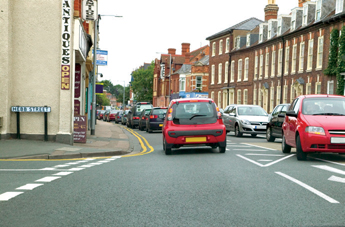
Irritation and anger, for whatever reason, are dangerous. They can cause mistakes, and mistakes lead to incidents.
If you’re angry, take time to compose yourself before a journey. Don’t jump into your vehicle when you’re angry. Wait until you’ve calmed down. The chance of an incident is too great to risk driving under such pressure.
•Give yourself plenty of time for your journey. Hurrying leads to mistakes, and mistakes lead to incidents.
•If it’s a long journey, plan enough time for breaks and refreshment.
•If you have a satellite navigation system, programme it before you start your journey. Don’t rely on it exclusively as it may have out-of-date or incomplete information at any given time.
•Use road and street maps before you set out, or check your route from the internet.
•Planning your journey to take the best route can also help you save fuel.
Getting lost can also lead to frustration and loss of concentration. Avoid rush hours around major cities if you can. Before you set out, plan your journey by visiting www.gov.uk or check the Highways Agency’s smartphone apps for live traffic updates. You could also listen to local and national radio for news of roadworks and traffic congestion.
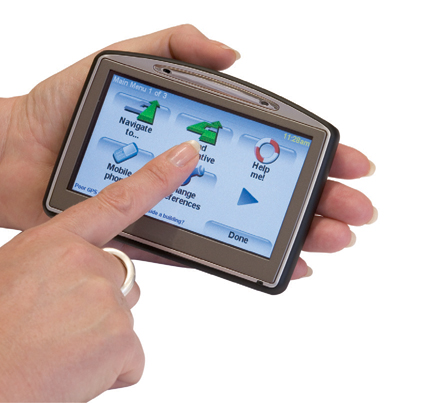
The weather is an important factor when you’re driving. If it’s really bad, it might be best to postpone your trip or use public transport. Always try to avoid driving in thick fog or icy conditions. It’s a much greater strain, and the risk of a road traffic incident is far higher.
Many drivers run into difficulties in very bad weather. Follow the weather forecasts and general advice to drivers through local and national media.
•Keep animals under control.
•Don’t allow animals loose in the vehicle.
•Don’t leave animals in a vehicle for any length of time, especially in hot weather.
•Never allow animals loose on the public road – they can cause incidents.
Many incidents happen close to home on regular daily or routine journeys. If you drive to work every day, don’t leave yourself the bare minimum of time to get there. More haste, less speed.
Don’t let familiarity with your home area and surroundings lead you to start taking risks simply because you feel you know every detail. Remember that strangers won’t have the benefit of local knowledge, so they might drive more cautiously than you feel they should.
All drivers must be able to read, in good daylight, a post-2001 number plate from 20 metres, with glasses or corrective lenses if necessary. If glasses or corrective lenses are required to read the number plate, they must be used while driving/riding. For more information on drivers’ eyesight requirements, please see www.gov.uk
You must
•be medically fit to drive
•understand that some medicines shouldn’t be taken if you intend to drive
•notify the Driver and Vehicle Licensing Agency (DVLA) in Swansea (Driver and Vehicle Agency in Northern Ireland) if your health is likely to affect your ability to drive either now or, because of a worsening condition, in the future.
Don’t drive if you’re feeling tired or unwell. Even a cold can make it unsafe for you to drive. If you find you’re losing concentration or not feeling well, keep your speed down and give yourself more time to react.
Physical fitness and mobility are also important. Make sure that you have full control of your vehicle at all times.
Remember that
•a twisted ankle can reduce pedal (including brake) control
•a stiff neck can make it difficult to look behind when reversing or checking blind spots.
Alcohol will seriously reduce your judgement and ability to drive safely. You must be aware that
•to drive with alcohol in your blood is extremely dangerous, and carries severe penalties if you drive or attempt to drive while over the legal limit
•if you drink in the evening, you might still be over the legal limit and unfit to drive the following morning.
Alcohol may remain in the body for around 24–48 hours. Your ability to react quickly may be reduced and the effects may still be evident the next morning. Your body tissues actually need up to 48 hours to recover. The only safe limit, ever, is a zero limit.
You MUST NOT drive if your breath alcohol level is higher than 35 µg/100 ml (equivalent to a blood alcohol level of 80 mg/100 ml).
Remember, be safe! If you drink, don’t drive! If you drive, don’t drink!

Illegal drugs Driving when you’re under the influence of illegal drugs is an offence. You mustn’t take any of the drugs that are generally accepted as ‘banned substances’ while driving or before you intend to drive.
Unlike alcohol (the effects of which last for about 24–48 hours), the effects of drugs can be unpredictable and you may not be aware of them. The direct effects of some drugs can last up to 72 hours.
The effects can be even more serious than alcohol, and may result in a fatal or serious road traffic incident.

Medicines Check any medicine you’re taking to see if it affects your ability to drive. Even medicines for coughs and hay fever can make you drowsy. Read the label and follow any recommendations given. Consult your doctor or pharmacist if you’re not sure. If still in doubt, don’t drive.
After a shock A shock or bereavement can badly upset your concentration. In this situation, avoid driving altogether.
Are you comfortable? Make sure you’re feeling comfortable. Wear sensible clothing for driving, especially on a long journey.
Shoes Shoes are particularly important. High heels and slippery soles can be dangerous on the pedals. Shoes that are too wide, or that easily fall off, can be just as dangerous.
It’s a good idea to keep a suitable pair of shoes in your vehicle, just for driving.
Driving while you’re tired increases your risk of being involved in a collision.
Don’t begin a journey if you feel tired – make sure you get a good night’s sleep before starting a long journey.
Try to avoid driving between midnight and 7.00 am because this is when the ‘body clock’ is in a daily trough.
If you begin to feel sleepy, stop in a safe place before you get to the stage of ‘fighting sleep’. Sleep can come upon you more quickly than you would imagine. You MUST NOT stop on the hard shoulder of a motorway to rest.
If it’s not possible to stop immediately, open a window for fresh air. Stop as soon as it’s safe and legal to do so.
The most effective ways to counter sleepiness are caffeine and a short nap. The combination of a caffeinated drink (for example, two cups of caffeinated coffee), followed by a short nap of up to 15 minutes, is particularly effective. This is because caffeine takes 20–30 minutes to be absorbed and act on the brain, hence the opportunity for a nap.
On a motorway, pull in at the nearest service area or leave the motorway. DO NOT pull up on the hard shoulder just to rest.
Don’t drive for too long without taking a break. Your concentration will be much better if you plan regular stops for rest and refreshments. It’s recommended that you take a break of at least 15 minutes after every two hours of driving. This is especially important at night.

Attitude is critical to a new driver’s approach, both to their own driving and to the actions and mistakes of other road users.
If you’re a novice, you need to use your sense of responsibility, patience and courtesy to develop the skills necessary to become a good driver.
A great deal of what you’ll learn will depend on your instructor.
A planned approach to learning is essential, particularly in the early stages.
Each lesson should be matched to your needs and abilities. There are no short cuts to becoming a good defensive driver (see page 201).
Who should teach you?
The best way to learn is by having
•regular planned lessons with a good professional instructor
•as much practice as possible.
Once you understand the basics, it’s a good idea to combine professional instruction with as much practice as you can with relatives and friends.
If you pay someone for tuition, they must be an approved driving instructor (ADI) (car) or a trainee licence holder.
Approved driving instructor (car)
An ADI must
•pass a rigorous three-part examination to qualify
•have their name entered on the register held by DSA
•display a green ADI identification certificate on the windscreen of the tuition vehicle
•reach and maintain the standards required by DSA.
Some trainee instructors who haven’t yet completed the qualifying examination are granted a trainee licence to enable them to gain instructional experience.
This is a pink identification certificate which must be displayed on the windscreen of the tuition vehicle.
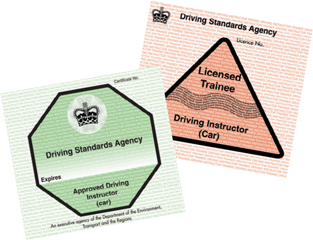
•Ask friends and relatives.
•Choose an instructor
–who has a good reputation
–who’s reliable and punctual
–whose vehicle suits you.
•Visit www.gov.uk for more information on ADI grading.
Take advice from your ADI on
•all aspects of driving
•what books to read or what DVDs, downloads, CD-ROMs, eBooks and apps are available
•when you’ll be ready for the driving test
•how to practise.
If you learn with an ADI, make sure that they cover the official syllabus fully. See the book, The Official DSA Guide to Learning to Drive. The syllabus is also shown in the Driver’s Record. The Driver’s Record, which also helps you to monitor your progress, is available from your ADI or downloadable from www.gov.uk
Since October 2010, all practical driving tests have included a period of independent driving. This assesses your ability to drive on your own while making decisions for yourself without instruction. The examiner will be looking for evidence that you have the required skills, knowledge and attitude to be a safe driver.
This section is an important element, because driving on your own is precisely what you’ll be able to do as soon as you’ve passed your driving test. The section will last for around 10 minutes, during which you’ll be asked to
•drive following traffic signs to a destination OR
•drive following a series of verbal directions
or a combination of both.
If you’re accompanying a learner, you should try to encourage confidence. It’s also important not to put them in a situation that requires more skill than they can be expected to show.
Don’t let them try to run before they can walk. Overestimating a learner’s skill could lead to disturbing incidents for both the learner and other road users. This can set back the learner’s progress and also be dangerous. Be aware that anyone supervising a learner must
•be at least 21 years of age
•have held for at least three years (and still hold) a full EC/EEA licence for the category of vehicle being driven.
The book, The Official DSA Guide to Learning to Drive, includes a section which will assist you in understanding what a learner driver needs to practise and will alert you to the hazards you may encounter when accompanying a learner driver.
The inexperienced often learn by example. They should, therefore
•be shown how to drive with quiet confidence
•have examples of bad driving explained and not excused
•be discouraged from developing bad habits and using excuses such as, ‘Everyone else does it, so why shouldn’t I?’
•learn from the good example that you demonstrate.
Taking on too much The enthusiastic learner should be very careful not to take on too much.
Over-confidence can lead to carelessness, risk-taking and, sometimes, tragic incidents.
The training vehicle A vehicle being driven by a learner must display L plates (or D plates in Wales), which should be removed or covered at all other times.
If you own a car or intend to buy one, it might be best to find a driving school that uses a similar model.
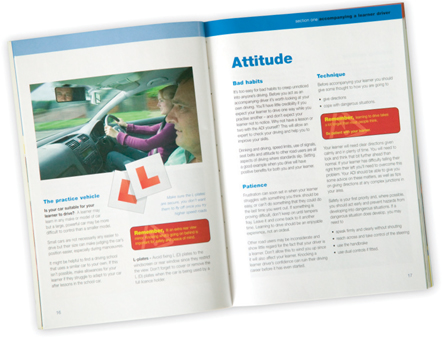
At a later stage, it might also be possible to have lessons in your own car. Avoid using a different vehicle for practice in the early stages. The controls and feel of the car will be so different that it might hinder rather than assist progress.
Avoid fixing L plates (D plates) to the windscreen or back window; they restrict your view.
Young and inexperienced drivers are more vulnerable on the roads. They can often be involved in incidents early in their driving careers, sometimes tragically so. Such incidents can usually be attributed to
•the natural exuberance of youth
•immaturity; an inability to cope with the serious nature of driving
•showing off to friends; ‘egging on’ by passengers looking for excitement
•competitive behaviour, racing and so on
•lack of experience and judgement, especially when driving ‘high-performance’ cars
•being over-confident of their own ability.
If you’re a new driver, avoid
•driving too fast; speed can kill
•reckless driving; drive with consideration and care
•showing off; if you want to impress your friends, show them how safe a driver you are
•being ‘wound up’; keep calm, learn to ignore the stupidity of others
•an aggressive attitude and behaviour; again, stay calm and safe
•loud music; this could interfere with your concentration or with your hearing at a critical moment
•driving beyond your capabilities; always leave yourself a safety margin
•being distracted by passengers.
Above all, be responsible and always show courtesy and consideration to other road users. Your life, and the lives of others, could depend on it!
False perceptions Many younger drivers wrongly believe that fast reactions and the ability to handle their vehicle will make them a good and safe driver. They fail to recognise that driving skill alone won’t prevent road traffic incidents.
Having the right attitude and a sound knowledge of defensive driving techniques is essential.
Pass Plus New drivers can take further training after they’ve passed their test.
Remember, be safe: don’t take risks!
The Pass Plus scheme was created by DSA for new drivers who would like to improve their basic skills and safely widen their driving experience. If you take the Pass Plus course, you may also receive reduced insurance premiums.
Ask your ADI for details of the scheme or visit www.gov.uk for more information.
Advanced driving courses Other organisations offer courses in advanced driving techniques. These are listed on page 365.
Although experienced, older drivers can also be vulnerable, but for different reasons. The natural and gradual deterioration in physical fitness and ability that comes with age can seriously affect judgement and concentration.
If you’re an older driver, be responsible and
•have your eyesight checked regularly, including your night vision
•don’t drive if you feel unwell
•take care when judging the speed of oncoming traffic at junctions. If in doubt, wait. Don’t make hasty manoeuvres. Look, assess and decide before you act
•keep concentrating on your driving – always!
•find a safe place to stop and rest if you feel tired
•keep up to date with the changes to rules and regulations – for example, new road markings and signs. Study the current edition of The Highway Code and put the advice it gives into practice
•take extra care – your reactions might not be as quick as they used to be.
Remember, recognise your own limitations and don’t take risks.

Advances in modern technology offer many more disabled people the chance to drive, and all standard vehicles can be modified for a disabled driver.
Many cars are available with automatic transmission and power-assisted steering to help the disabled driver.
These can include
•hand controls for braking and acceleration
•steering and secondary control aids
•left-foot accelerator conversions
•clutch conversions
•parking brake devices
•additional car mirrors
•seat belt modifications
•harnesses
•special seating
•wheelchair stowage equipment.
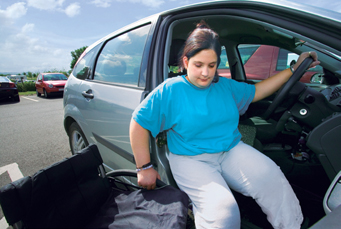
For the more severely disabled driver
•joystick and foot steering; a four-way joystick can now be used to steer, accelerate and brake
•infra-red remote control systems which enable a driver to enter a vehicle and drive from a wheelchair with complete independence.
Driving assessment centres for disabled persons are available to
•test driving ability
•give advice on the sort of controls and adaptations needed to drive safely and in comfort.
A list of some mobility centres is given on page 366, although this isn’t exhaustive. Visit mobility-centres.org.uk/find_a_centre for a complete list. You could also visit motability.co.uk for information about financing modifications and adaptations.
The major motoring organisations and some motor manufacturers offer special services for disabled drivers.
Severely disabled persons might qualify for parking concessions. Contact your local authority to apply for the Blue Badge scheme or visit www.gov.uk for more information.